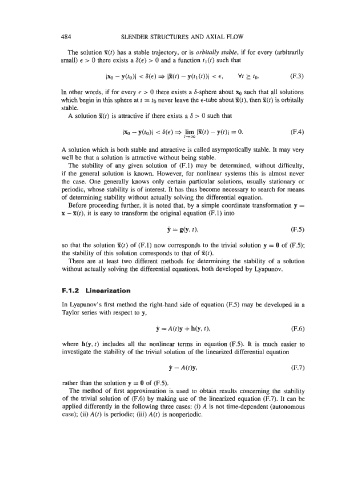Page 514 - Fluid-Structure Interactions Slender Structure and Axial Flow (Volume 1)
P. 514
484 SLENDER STRUCTURES AND AXIAL FLOW
The solution f(t) has a stable trajectory, or is orbitally stable, if for every (arbitrarily
small) E > 0 there exists a &E) > 0 and a function tl(r) such that
In other words, if for every E > 0 there exists a 6-sphere about xo such that all solutions
which begin in this sphere at t = to never leave the €-tube about %(t), then X(t) is orbitally
stable.
A solution X(t) is attractive if there exists a 6 > 0 such that
A solution which is both stable and attractive is called asymptotically stable. It may very
well be that a solution is attractive without being stable.
The stability of any given solution of (F.l) may be determined, without difficulty,
if the general solution is known. However, for nonlinear systems this is almost never
the case. One generally knows only certain particular solutions, usually stationary or
periodic, whose stability is of interest. It has thus become necessary to search for means
of determining stability without actually solving the differential equation.
Before proceeding further, it is noted that, by a simple coordinate transformation y =
x - K(t), it is easy to transform the original equation (F.l) into
so that the solution R(t) of (F.l) now corresponds to the trivial solution y = 0 of (F.5);
the stability of this solution corresponds to that of f(t).
There are at least two different methods for determining the stability of a solution
without actually solving the differential equations, both developed by Lyapunov.
F.1.2 Linearization
In Lyapunov’s first method the right-hand side of equation (F.5) may be developed in a
Taylor series with respect to y,
where h(y, t) includes all the nonlinear terms in equation (F.5). It is much easier to
investigate the stability of the trivial solution of the linearized differential equation
rather than the solution y = 0 of (F.5).
The method of first approximation is used to obtain results concerning the stability
of the trivial solution of (F.6) by making use of the linearized equation (F.7). It can be
applied differently in the following three cases: (i) A is not time-dependent (autonomous
case); (ii) A(t) is periodic; (iii) A(t) is nonperiodic.

